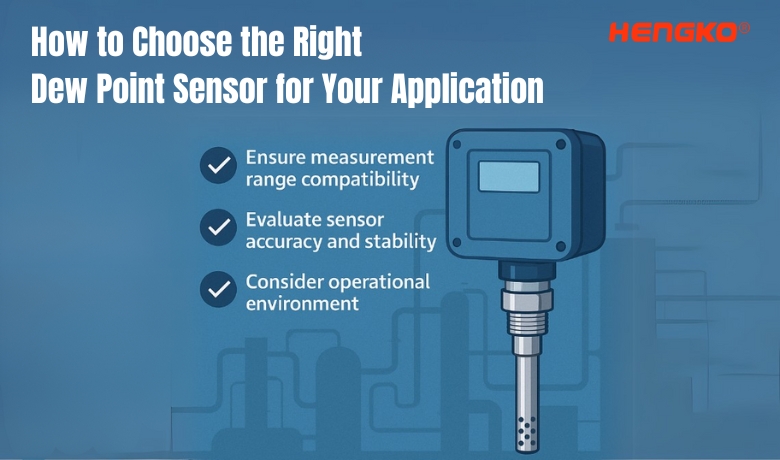High-Precision Dew Point Transmitters for Industrial Applications
Introduction: Why Selecting the Right Dew Point Transmitter Matters
I’ve seen firsthand how overlooked dew point monitoring can silently cost a company thousands—or even millions. Early in my career, we faced an unexpected production halt due to moisture contamination in a compressed air system. The root cause? An inaccurate, poorly chosen dew point instrument. Effective compressed air measurement is crucial in maintaining system efficiency and preventing costly downtime. Air compression increases water vapor pressure and affects the dew point temperature, making it essential to understand these changes to avoid issues like condensation in pressurized air systems. It wasn’t just a technical oversight—it was a business loss. (Insert personal story or case study here)
When moisture levels go unchecked, the consequences are real and costly:
*Unexpected production downtime
*Defective products due to condensation or contamination
*Wasted energy, especially in overcompensating air dryers
*Increased maintenance and faster equipment degradation
Over the years, I’ve worked with clients across multiple sectors
— from pharmaceuticals and cleanrooms to gas drying units and compressed air systems
— and I’ve learned one key truth: the right dew point sensor prevents costly problems before they even occur.
“Will this sensor keep my process stable, my equipment protected, and my quality standards intact?”
In short, it’s not just a technical decision — it’s a strategic one.
When you select the correct dew point transmitter, you gain:
*Improved system reliability
*Fewer unexpected shutdowns
*Higher and more consistent product quality
*Lower maintenance and operating costs over time
Need help selecting a dew point sensor for your system?
Learn about comfortable dew points to make an informed decision.
Let our engineers assist — contact us for a free consultation.
Understanding Dew Point
Dew point is the temperature at which air becomes saturated with water vapor and can no longer hold any more moisture, leading to condensation. The atmospheric dew point refers to the dew point temperature in non-pressurized air, while the pressure dew point is measured under varying atmospheric pressure conditions. This dew point temperature is a critical parameter in various industries, including compressed air systems, industrial drying processes, and quality control. Understanding dew point is essential for maintaining energy efficiency, preventing system failures, and ensuring the quality of products.
In compressed air systems, excessive moisture can cause corrosion, contamination, and equipment damage. Accurate dew point measurements are crucial to avoid these issues. High-quality dew point sensors and transmitters provide reliable and precise readings, helping industries maintain optimal moisture levels and protect their equipment. By understanding and monitoring dew point, businesses can enhance their operational efficiency and product quality.
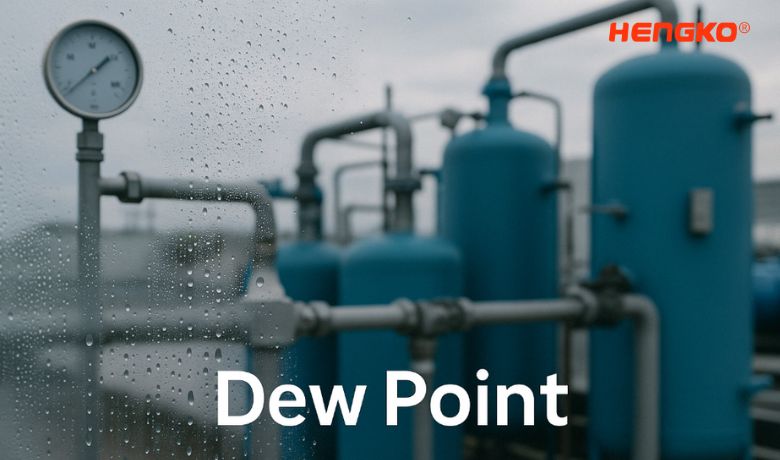
Importance of Dew Point Measurement in Compressed Air
Compressed air systems typically produce compressed air with a high dew point, which can lead to moisture-related problems such as corrosion and contamination. Measuring dew point in compressed air systems is essential for maintaining the quality of the air and preventing equipment damage. Dew point measurement ensures that the compressed air is dry and free of moisture, which is critical for various industrial applications, including plastics drying and medical gases.
The importance of dry compressed air in industrial processes cannot be overstated. Effective monitoring is necessary to prevent over-drying and energy wastage, ensuring that only dry compressed air meeting specific standards is used to maintain smooth production and product quality.
The importance of dew point measurement in compressed air systems cannot be overstated, as it directly affects the efficiency, reliability, and safety of the system. By installing dew point sensors and transmitters, industries can monitor and control the dew point of their compressed air systems, reducing maintenance costs and improving overall performance. Accurate dew point measurements help to ensure that the air used in industrial processes is of the highest quality, preventing costly downtime and product defects.
Fundamentals of Dew Point Sensors
Dew point sensors are designed to measure the dew point temperature of a gas or air stream, providing accurate and reliable readings. The fundamentals of dew point sensors involve the use of specialized materials and technologies, such as capacitive or resistive sensors, to detect changes in humidity and temperature. These sensors are typically calibrated to provide accurate measurements over a specific range of temperatures and humidity levels.
Dew point meters are crucial in various applications and functionalities, emphasizing their importance in accurately measuring and calibrating dew point levels across different environments, including industrial settings and portable use. They are capable of displaying temperature and maintaining precision.
The sensor body material and design play a critical role in ensuring accurate and reliable measurements, as well as withstanding harsh environmental conditions. Dew point sensors are available in various configurations, including standalone smart probes, remote mount temp sensors, and stainless steel single-output sensors, to suit different applications and requirements. By choosing the right sensor for their specific needs, industries can achieve precise measurement and maintain optimal moisture levels in their processes.
Dew Point Measurement Methods
Dew point measurement methods are essential for ensuring accurate and reliable readings in various industrial applications. Here are the primary methods used to measure dew point:
Chilled Mirror Hygrometry:
*This method involves cooling a mirror until dew or frost forms on its surface. The temperature at which this happens is the dew point temperature.
*Chilled mirror hygrometry is known for its high accuracy and is often used in calibration labs and other applications where precision is critical.
Capacitive Hygrometry:
*Capacitive hygrometry measures the dew point by observing changes in capacitance. This method is widely used in industrial applications due to its reliability and accuracy.
*Capacitive sensors are ideal for environments where high accuracy is required, such as compressed air systems and industrial drying processes.
Psychrometry:
*Psychrometry uses two thermometers – one dry and one wet – to determine relative humidity. The dew point can then be found using psychrometric charts or equations.
*This method is useful for general humidity measurements but may not be as precise as other methods for dew point measurement.
Impedance Hygrometry:
*Impedance hygrometry measures humidity by observing changes in the electrical impedance of a hygroscopic material. This method is often used in industrial applications where high accuracy is required.
*Impedance sensors are suitable for environments with varying humidity levels and are commonly used in compressed air systems and quality control processes.
By understanding these methods, industries can choose the most appropriate dew point measurement technique for their specific needs, ensuring accurate and reliable readings.
Factors Affecting Dew Point Measurement
Several factors can impact the accuracy of dew point measurements, making it essential to consider
these elements when selecting and using dew point sensors:
1.Temperature:
*Temperature fluctuations can affect the accuracy of dew point measurements.
It’s crucial to use sensors that are calibrated for the specific temperature range of your application.
2.Humidity:
*High humidity levels can influence the performance of dew point sensors.
Ensuring the correct measuring range and using sensors designed for high humidity environments can help maintain accurate measurements.
3.Air Pressure:
*Changes in air pressure can impact dew point readings. High pressure and high temperature sensors are necessary for accurate measurements in compressed air systems.
4.Sensor Body Material:
*The material of the sensor body can affect its durability and accuracy. Using materials that are resistant to corrosion and contaminants can help maintain reliable measurements.
5.Contaminants:
*The presence of contaminants in the air stream can interfere with dew point measurements. Regular maintenance and calibration of the dew point instrument are necessary to ensure accurate readings and reduce maintenance costs.
By considering these factors, industries can achieve accurate dew point measurements, ensuring the reliability and efficiency of their processes.

Common Questions Buyers Ask Before Purchasing
Choosing the right dew point transmitter isn’t just about technical specs—it’s about ensuring system uptime, product quality, and long-term cost savings. Below are five critical questions that experienced procurement managers, plant engineers, and system integrators ask before making a decision:
Here are the some most common questions buyers ask me:
1.What dew point range do I need for my application?
Different processes require different dew point levels. The dew point temperature can differ at the measurement point when measuring gases under pressure compared to the dew point within the process. Here’s a quick guide: Understanding dew point temperatures and pressure dew point is crucial for accurate measurement and efficient moisture management in various applications, such as compressed air systems and high-pressure gases.
|
Application |
Typical Dew Point Requirement |
|---|---|
|
Compressed air systems |
-20°C to -40°C |
|
Desiccant air dryers |
-40°C to -70°C |
|
Refrigerated dryers |
0°C to -20°C |
|
Gloveboxes / Cleanrooms |
≤ -60°C |
|
Natural gas & petrochemicals |
-40°C to -100°C |
Tip: Choosing a sensor outside your required range will lead to inaccurate readings or sensor failure. Need help matching your specs? Talk to our engineers →
2. Which sensor is reliable under harsh or corrosive environments?
If your process involves high humidity, chemicals, or extreme temperatures, you need a robust sensor.
*Look for IP65 or IP67 housing
*Stainless steel or PTFE-coated probes for chemical resistance
*Anti-condensation and dust-resistant protection caps
*Sensors with a long calibration interval to reduce maintenance costs
HENGKO’s HG808 series is engineered specifically for tough environments—ask about our corrosion-resistant options.
3. Can this sensor integrate with our PLC/SCADA system?
Compatibility is key. Most industrial environments require:
*Analog outputs: 4–20mA, 0–10V
*Digital communication: RS485 (Modbus RTU), HART, or optional Wi-Fi
*Direct wiring to controllers or remote monitoring systems
We support a wide range of protocols—send us your system type and we’ll recommend a compatible model.
4. What is the lifespan and recalibration interval?
*Industrial-grade sensors should last 3–5 years in typical use
*Calibration is usually recommended once per year
*Some models offer remote or field calibration for reduced downtime
Ask us about sensors with low drift and extended calibration intervals to minimize maintenance.
5. What’s the lead time—and is OEM/customization available?
*Standard models ship in 5–10 business days
*OEM or bulk production options available with flexible MOQ
*Custom designs: flange type, thread size, signal output, or branding support
Need custom specs? Our R&D team supports OEM/ODM sensor development for global industrial clients.
Ready to discuss your needs?
Share your application details with us
—our technical team will recommend the best-fit dew point sensor and send a quote within 24 hours.
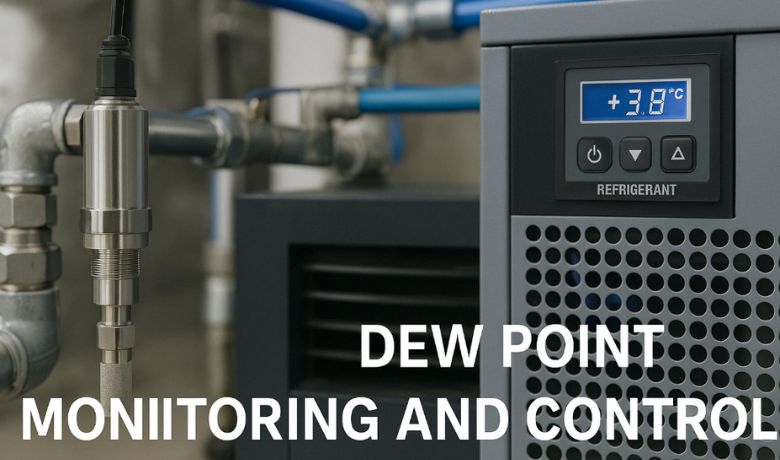
Select by Application Type – What Dew Point Sensors Should You Use?
Whenever someone asks me which dew point sensor is best, my response is always the same: “It depends entirely on your application.” Over the years, I’ve helped dozens of clients across industries—from compressed air systems to cleanroom environments—select the right model for their unique needs. Below is a quick reference table based on real-world use cases I’ve worked with. This table also highlights the typical applications for each sensor type to help you understand which solution best fits your needs.
|
Industry Application |
Recommended Range |
Suggested Model |
Output |
Features to Look For |
|---|---|---|---|---|
|
Compressed Air Systems |
-20 to -40°C |
HENGKO HG808-T / Michell Easidew |
4–20mA, RS485 |
IP65, fast response, stability |
|
Refrigeration Dryers |
0 to -20°C |
CS Instruments FA510 |
0–10V |
Moisture resistance |
|
Desiccant Dryers |
-40 to -70°C |
HENGKO HG808-DP / Vaisala DMT152 |
4–20mA, Modbus |
High accuracy, low drift |
|
Glove Boxes / Cleanrooms |
≤ -60°C |
Michell MDM300 (portable) |
Display / USB |
Calibration access, fast reading |
|
Natural Gas / Petrochemicals |
-40 to -100°C |
COSA Xentaur XPDM |
HART, 4–20mA |
Explosion-proof, stainless steel |
|
Plastic Dryers |
-20 to -40°C |
HENGKO HG808-T / Michell Easidew |
4–20mA, RS485 |
Compatibility with plastic dryers, ensures dry compressed air |
Each industry comes with its own environmental challenges, whether it’s pressure, corrosion, or tight control standards. That’s why choosing a sensor tailored to your application isn’t optional—it’s essential.
I often tell customers: if you’re running a desiccant dryer but choose a low-range sensor, you’re setting yourself up for unreliable readings and frequent maintenance. The key is matching both the measurement range and the sensor’s durability with your actual process environment.
Need help matching your industry to the right sensor? Share your application details with us, and we’ll send you model recommendations within 24 hours. Contact us here.
Select by Dew Point Sensor Type – Which Technology Fits Best?
Choosing the right measurement technology is just as important as selecting the right sensor model. I often get asked, “What type of dew point sensor is best for our system?” The answer depends heavily on your accuracy requirements, operating conditions, and budget.
Here’s a breakdown of the main sensor types I’ve worked with over the years and when I recommend each: Sensor calibration is crucial for maintaining accuracy and ensuring proper function, especially as certain parts and models are being discontinued.
|
Type |
Measurement Principle |
Accuracy |
Cost |
Best Use Case |
Pros & Cons |
|---|---|---|---|---|---|
|
Capacitive |
Polymer-based humidity absorption |
±2°C |
$$ |
General industrial |
Reliable, good value |
|
Chilled Mirror |
Optical condensation |
±0.2°C |
$$$$ |
Calibration labs |
Ultra-accurate, high maintenance |
|
Aluminum Oxide |
Electrical impedance |
±1°C |
$$$ |
Oil & gas, desiccant dryers |
High-pressure tolerance |
|
Polymer |
Low-cost capacitive |
±5°C |
$ |
HVAC, non-critical apps |
Basic monitoring only |
I’ve helped many clients save time and money by aligning their sensor choice with both technical requirements and operational conditions. It’s easy to over- or under-spec a sensor if you’re unfamiliar with these differences.
Buyer Tip: If you’re unsure, capacitive sensors are usually the most versatile starting point for industrial use. They offer a strong balance of reliability, cost-efficiency, and compatibility across a range of systems.
Need help deciding which type suits your operation best? Our team is happy to walk you through the pros and cons based on your industry. Get in touch with us here.
Select by Operating Environment – What Conditions Will the Sensor Face?
One of the biggest mistakes I see buyers make is choosing a dew point sensor without considering the environment it’s going into. Over the years, I’ve helped troubleshoot installations where the sensor worked fine—until it was exposed to extreme humidity, corrosive gases, or dust-heavy air. That’s why environmental compatibility is always one of the first things I ask about.
Here’s a breakdown of common environmental challenges and what design features to prioritize:
|
Environmental Factor |
Design Considerations |
Important Notes |
|---|---|---|
|
High Humidity >90% RH |
IP65/IP67, stainless steel body, condensation-proof |
Use sintered protective caps or hydrophobic filters |
|
High Temperature >80°C |
Remote probe design with heat insulation |
Keep electronics cool for longer life |
|
Corrosive Gases |
PTFE-coated probe or special alloys |
Confirm material compatibility with your gas |
|
Dusty / Abrasive Air |
Sintered filters, easy-clean design |
Schedule regular inspection or cleaning |
|
Ambient Temperature |
Temperature-stable materials, proper ventilation |
Ensure air treatment to manage dew point |
|
Low Humidity |
Static-resistant materials, accurate humidity sensors |
Monitor to prevent equipment malfunction |
Every environment has hidden risks that can shorten sensor life or lead to inaccurate readings. For example, I once had a customer install a basic sensor in a chemical plant—within weeks, it corroded beyond use. Once we switched to a PTFE-coated model, their readings stabilized, and downtime dropped.
By matching the right housing, filtration, and protective features to your site conditions, you’ll protect your investment and ensure consistent performance.
Not sure if your environment requires a ruggedized sensor?
We’ve helped clients in over 20 industries.
Talk to us today, and we’ll help you choose the right protection level.
Dew Point Monitoring in Various Industries
Dew point monitoring is a critical component in many industries, helping to maintain product quality
and system efficiency. Here are some key applications:
1.Compressed Air Systems:
*Dew point monitoring in compressed air systems helps prevent corrosion and contamination,
ensuring the quality of the compressed air.
This is essential for applications such as medical gases and plastics drying.
2.Industrial Drying Processes:
*Monitoring the dew point in industrial drying processes helps optimize the drying process,
preventing over-drying or under-drying. This is crucial for maintaining product quality and energy efficiency.
3.Quality Control:
*In quality control, dew point monitoring ensures that humidity and dew point levels are maintained
within specified ranges, preventing defects and ensuring product consistency.
4.Medical Gases:
*Dew point monitoring in medical gases ensures the safety and quality of the gases used in
medical applications, preventing moisture-related issues.
5.Natural Gas and Plastics Drying:
*In natural gas processing, dew point monitoring helps prevent condensation and ensures the quality of the gas.
In plastics drying, it helps maintain the correct moisture levels for optimal product quality.
By implementing dew point monitoring, industries can enhance their operational efficiency, reduce maintenance costs,
and ensure the quality and safety of their products.
The Role of Dew Point in HVAC Systems
Dew point plays a crucial role in HVAC systems, affecting both humidity and temperature levels within a building. Here’s how:
1.Optimal Cooling and Heating Settings:
*The dew point temperature is used to determine the optimal cooling and heating settings for a building.
This helps prevent over-cooling or over-heating, ensuring a comfortable indoor environment.
2.Humidity Control:
*Dew point monitoring helps control humidity levels in HVAC systems, preventing moisture-related problems
such as mold and mildew growth. This is essential for maintaining a healthy indoor environment.
3.Energy Efficiency:
*By monitoring the dew point, HVAC systems can optimize their energy usage, reducing the energy
required for cooling and heating. This leads to lower energy costs and improved energy efficiency.
4.Accurate Dew Point Measurements:
*Accurate dew point measurements are essential for maintaining a comfortable and healthy
indoor environment. They help ensure that the HVAC system operates efficiently and effectively,
reducing maintenance requirements.
By understanding the role of dew point in HVAC systems, industries can improve their energy efficiency,
reduce costs, and maintain a comfortable and healthy indoor environment.
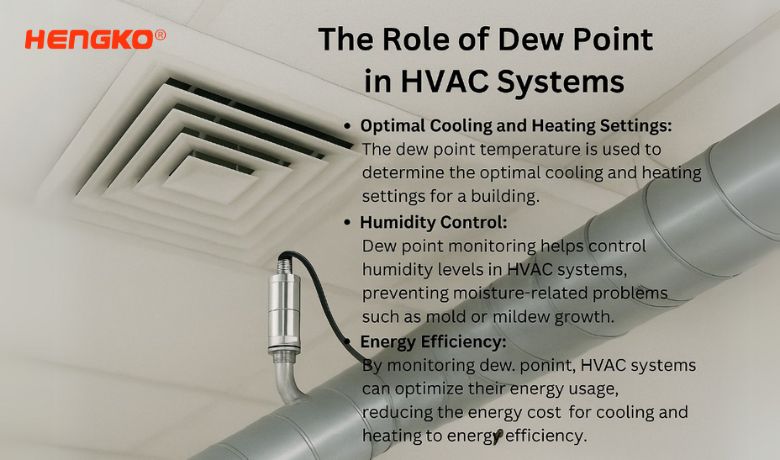
Dew Point Monitoring and Control
Dew point monitoring and control are critical components of compressed air systems, as they help to maintain the quality of the air and prevent moisture-related problems. Dew point monitoring involves the use of sensors and transmitters to measure the dew point temperature of the air stream, providing real-time data and alerts. This information allows industries to implement control strategies, such as refrigerant dryers and desiccant drying systems, to regulate the dew point of the compressed air, ensuring it meets the required specifications.
Refrigerant dryers utilize a cooled heat exchanger to condense water vapor out of the air stream, thereby affecting the dew point of the compressed air.
Accurate dew point measurements and control are essential for maintaining energy efficiency, reducing maintenance costs, and preventing system failures. By implementing dew point monitoring and control, industries can optimize their compressed air systems, improve product quality, and reduce energy costs. Continuous monitoring ensures that any deviations in dew point are quickly detected and corrected, maintaining the reliability and efficiency of the system.
Benefits of Using Dew Point Sensors
Using dew point sensors in industrial systems offers a wide range of operational and economic advantages.
These sensors are essential for maintaining optimal moisture control, especially in environments
where precision and reliability are critical.
Key benefits include:
*Accurate and reliable measurements across a wide range of dew point temperatures—from extremely low to moderately high
*Real-time data and alerts, enabling faster responses to environmental changes
*Reduced maintenance costs by preventing corrosion, contamination, and unnecessary equipment wear
*Improved energy efficiency, especially when integrated with drying systems or climate controls
*Higher product quality and process stability by keeping moisture within acceptable limits
*Fewer system failures and unplanned downtimes, boosting operational continuity
*Enhanced competitiveness through better compliance with industry standards and reduced operational costs
Dew point sensors are available in multiple configurations, including fixed, portable, remote-mounted,
and OEM-customized options. Their easy integration into compressed air systems makes them a
versatile and scalable solution across industries like pharmaceuticals, food processing, electronics, and petrochemicals.
By investing in high-performance dew point transmitters, companies can ensure precise moisture monitoring,
optimize system performance, and protect product integrity—ultimately driving long-term productivity and profitability.
What Parameters Should You Always Check Before Ordering?
One thing I always stress to customers is this: don’t assume all dew point sensors are built the same.
You might find two models with similar specs on paper, but only one of them will truly meet the demands of your process.
That’s why I created a checklist that every serious buyer should follow before placing an order.
Here are the key parameters I always ask clients to confirm:
- Measurement range (dew point or frost point): Make sure it covers both your lowest and typical operating conditions.
- Output signal (analog, digital, Modbus, HART): Check compatibility with your existing control system or PLC.
- Accuracy and repeatability:
Especially important for pharmaceutical, food, or electronics applications.
Learn more about laboratory temperature and humidity control requirements.
- Housing type and protection rating: Is it IP65, IP67, stainless steel, explosion-proof?
- Response time: A faster sensor can mean earlier problem detection and better control.
- Certifications (such as ATEX, CE, RoHS): Required in many regulated industries or export markets.
- OEM or customized connection options:
Need a special flange? Branded housing? We support full OEM capability at HENGKO.
Too many times, I’ve seen customers choose a lower-cost sensor without realizing it lacked the right signal type
or housing for their application.
A quick technical check upfront can save you weeks of rework or even system downtime.
Comparison Chart – Dew Point Transmitter Selection Made Simple
When I help customers narrow down sensor choices, I often use comparison tables like this one to make the decision easier.
Here’s a quick side-by-side of some of the most commonly used dew point transmitters I’ve worked with or recommended:
A comprehensive range of options is available to meet different industrial needs, ensuring reliability and precision in measurements.
|
Model |
Range |
Accuracy |
Output |
Use Case |
Cost |
Remarks |
|---|---|---|---|---|---|---|
|
HENGKO HG808-T |
-40 to +60°C |
±2°C |
RS485 / 4–20mA |
Compressed air systems |
$$ |
Rugged, stainless steel housing |
|
Michell Easidew |
-100 to +20°C |
±1°C |
2-wire loop |
Gas drying, dryers |
$$$ |
Widely used in OEM dryers |
|
COSA XPDM |
-100 to 0°C |
±0.2°C |
HART |
Oil & gas, ATEX zones |
$$$$ |
Explosion-proof design |
This kind of chart helps my clients weigh performance, compatibility, and cost—especially when multiple sites or regions are involved.
It’s a great tool for standardizing your sensor selection process.
Case Study: How One Factory Cut Maintenance Downtime by 40%
Let me share a real example from a petrochemical client I supported last year:
*Industry:
Petrochemical (chlorinated compound production)
*Problem:
Frequent sensor failures caused by corrosive gas and high humidity
*Previous Setup:
A standard capacitive sensor with no protective coating, resulting in inaccurate readings and constant recalibration
*Solution:
We upgraded them to the HENGKO HG808-H—built for high-humidity and harsh gas environments
*Result:
The new sensor ran stably for 9+ months without recalibration, reduced downtime by over 40%, and provided a consistent
signal back to their DCS. It is also important to consider process pressure in sensor selection to ensure accurate
dew point measurements and reliable performance.
Situations like this are common—and avoidable—if you choose a sensor designed for your real-world environment.
Want similar results?
Let’s discuss your system requirements and help you select a sensor that lasts longer and performs better. Contact us today.
Top 6 Mistakes to Avoid When Choosing a Dew Point Sensor
Over the years, I’ve seen customers run into trouble
—not because they didn’t do research, but because they focused on the wrong things.
If you’re selecting a dew point transmitter, avoid these six common mistakes:
- Focusing only on price instead of long-term reliability:
A cheap sensor that fails in 6 months costs more than a high-quality one that lasts 5 years.
- Ignoring signal compatibility with your PLC/DCS:
I’ve had to troubleshoot many systems where the sensor output didn’t match the automation input—costing hours of rework.
- Underestimating environmental challenges:
Temperature, humidity, and corrosive gases matter. The wrong housing or protection rating can shorten sensor life dramatically.
- Buying non-industrial-grade components:
Consumer-grade sensors simply won’t survive in industrial environments. Always check IP rating, probe material, and certifications.
- Forgetting about calibration access and replacement parts:
Downtime for recalibration is costly. Ask whether the sensor can be recalibrated in-house or easily replaced.
- Choosing a non-OEM-compatible model:
If you’re planning to scale or integrate across multiple systems, make sure the sensor supports OEM customization or standardized connection types.
By steering clear of these mistakes, you’ll choose a dew point transmitter that delivers real value—not just on day one, but for years to come.
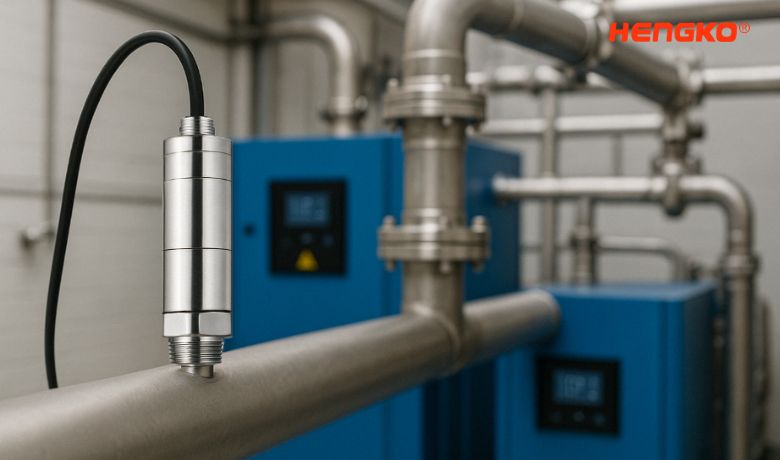
Frequently Asked Questions
Here are some of the most common questions I receive from engineers and procurement teams.
These also happen to be some of the top Google search queries related to dew point sensors:
*What is the ideal dew point for compressed air systems?
Typically between -20°C and -40°C for standard industrial air systems. Desiccant dryers can go down to -70°C.
*Can I use a humidity sensor instead of a dew point transmitter?
No. Humidity sensors measure relative humidity, not dew point, and are often not accurate in low-moisture conditions.
*What happens if my dew point sensor is exposed to liquid water?
It may become damaged or inaccurate. Always use protective sintered filters or install the probe away from condensation zones.
*How often should the sensor be calibrated?
For most industrial use cases, every 6–12 months. Some high-precision applications may require more frequent checks.
*Is it better to choose portable or fixed-type dew point monitors?
Portable monitors are great for spot checks and maintenance.
Fixed transmitters are better for continuous monitoring and process control.
*What is a dew point meter and what are its applications?
A dew point meter is a device that measures temperature, humidity, and dew point in various environments.
It is crucial for applications requiring precise control of moisture levels, such as industrial processes, calibration tasks,
and maintaining optimal conditions in different settings.
Still have questions? Our team is happy to help. Reach out to us here for expert advice tailored to your application.
Final Thoughts:
Better Sensors = Better System Reliability
From what I’ve seen in the field, choosing the right dew point transmitter makes a real difference.
It’s not just about meeting specs—it’s about ensuring long-term process stability, reducing downtime, and protecting every component that relies on clean, dry air or gas.
When you invest in the right sensor, you:
*Minimize system failures caused by moisture
*Maintain product quality and compliance
*Lower maintenance and calibration costs
*Improve trust in your monitoring data
*Benefit from advanced measurement solutions with stand-alone smart probes
In short: don’t guess—choose with confidence.
Tell us your application, environment, and preferred specs
— we’ll shortlist the right dew point transmitters for you within 24 hours. Get Your Quote Now.
Post time: Apr-21-2025
